When mentioning the oldest ancient structure of Western culture, everyone’s mind goes to Stonehenge. Erected about 7000 years ago, as if saluting the sky in perfect harmony, these massive stones trigger the imagination of many. How did our ancestors know the stars so well, how could they stack these stones on top of each other without technology? Then there are the Egyptian pyramids, believed by millions of people to have been built by aliens with 100% certainty. We all know that the Egyptians were a highly advanced civilization. Yet, the idea that ancient humans built these engineering marvels 4000 years ago feels like a miracle.

What if we told you that there is a temple built 9000 years before the Egyptian pyramids, 6000 years before Stonehenge? Göbekli Tepe, located a few kilometers from the city of Şanlıurfa in Turkey, dates back to the 10th millennium BC. This makes it the oldest known ancient temple of humanity.
The First Habitat of Humanity
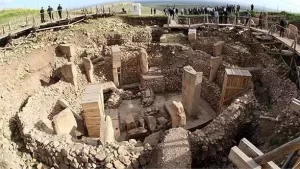
Göbekli Tepe is located in Çatalhöyük, one of the largest Neolithic settlements discovered to date. Built over 9000 years ago in the modern Konya Plain in the center of Turkey, this city is known in archaeology as a proto-city. Until Çatalhöyük, we thought prehistoric humans still lived in cave dwellings as hunter-gatherers. However, Çatalhöyük, at 9000 years old, is an entire city! This is the first place in history where communities lived a city-like life in a pre-planned and systematic way. It’s where they began to cultivate crops and herd animals, marking the first transition to settled life. And in the world’s first urbanizing society, the seeds of belief were also sown.
The Birth of the Belief System
Ancient site Göbekli Tepe was officially discovered in 1994 by German archaeologist and historian Klaus Schmidt. Studies show that these structures date back to around 11,000 years ago, or the 10th millennium BC. This indicates that hunter-gatherer communities had complex social structures even before transitioning to settled life.
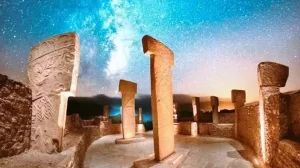
Within this archaeological site, which is 15 meters high and has a diameter of 300 meters, more than 200 pillars are constructed to form 20 different circles. Each pillar is 6 meters tall and weighs 10 tons. The most focused hypothesis due to the pillars’ alignments with the stars, their exceptionally well-drawn animal figures for their era, and other details, is that Göbekli Tepe was a place of worship. If true, this would make ancient Göbekli Tepe the oldest temple in human history. Moreover, it proves that the people of that period had developed religious beliefs to a sophisticated level. Their ability to construct such large structures also speaks to their advanced social organization.
Civilization and Religion
About 10,000 years ago, our ancestors made one of the most significant changes in human history and left behind their nomadic life. What was the reason for this decision change, known as the “Neolithic Revolution”? Once, the answer was clear and straightforward: food. Farming and agriculture were much more efficient than hunting and gathering. Inevitably, our ancestors were drawn to this lifestyle. Cities, writing, and organized religion were also outcomes of this transition. However, the 11,000-year-old archaeological findings at Göbekli Tepe have turned what we know about this equation upside down.
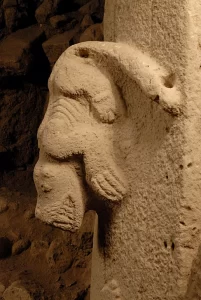
All findings related to the majestic structure unearthed at Göbekli Tepe indicate that it was used for religious ceremonies. This leads to the emergence (or strengthening) of an interesting theory regarding the origins and reasons for the transition to settled life: The shift to settled living may have had religious foundations!
This imposing structure was built not by settled farmers but by nomads. To complete this massive project, they needed to settle down. Therefore, the reason for the Neolithic Revolution might not have been agriculture but religion.
Hungary Soul or Hungary Stomach?
Of course, some other archaeologists oppose this idea. However, despite all objections, the idea of transitioning to settled life for ceremonial purposes is quickly gaining strength. Leaving nomadism just to satisfy our hunger doesn’t seem that cool after all. Moreover, other findings from various parts of the world seem to support this idea. For example, the ancient Maya city structures of El Ceibal and the Neolithic remains found in the Levant region of the Middle East.
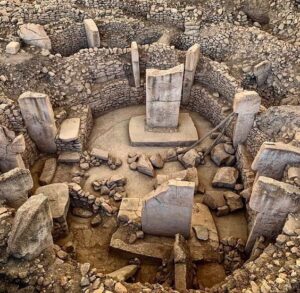
The parallels between the reasons for these two civilizations, at opposite ends of the world, to transition to settled life are striking and intriguing. If the Mayans transitioned to settled life for the same reasons as our ancestors in the Middle East, this could provide valuable information about the cultural evolution of humans: The fact that spiritual needs played a driving role in the rise of civilizations.
Heirs of a Lost Civilization
Göbekli Tepe has the capacity to completely demolish our perceptions about humanity. A need not as worldly as hunger, but rather of a more spiritual dimension, may have triggered this move that changed our common history. Yet, the remains uncovered at Göbekli Tepe also lay the groundwork for the emergence of even more interesting theories.
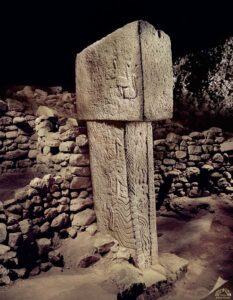
British author and journalist Graham Hancock’s theory is one of them. Hancock’s most popular and controversial theories is about a “lost civilization” that existed more than 10,000 years ago. Way before the end of the last Ice Age. He suggests that this civilization possessed advanced knowledge and technology. However it was lost due to a cataclysmic event. According to Hancock, it was probably a massive flood. Hancock argues that remnants of this lost knowledge can be found in the myths, legends, and architectural achievements of ancient societies around the globe. Such as Egyptian pyramids or the megalithic structures of Göbekli Tepe.
You can watch Graham’s claims about Göbekli Tepe in Episode 5 of Netflix’s Ancient Apocalypse documentary, “Mysteries of Göbekli Tepe.”
